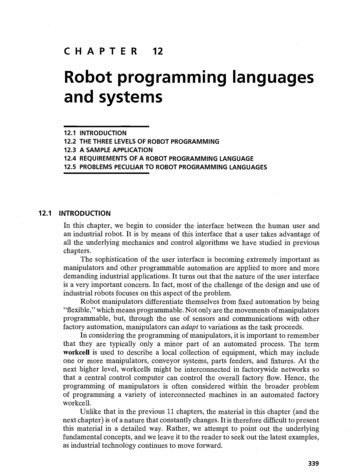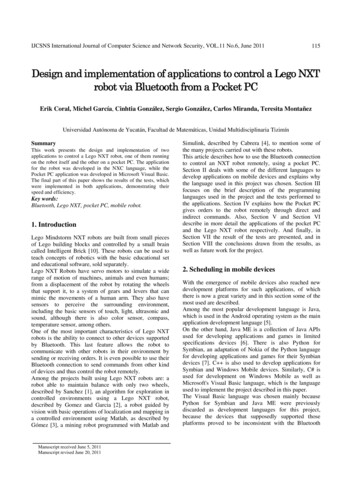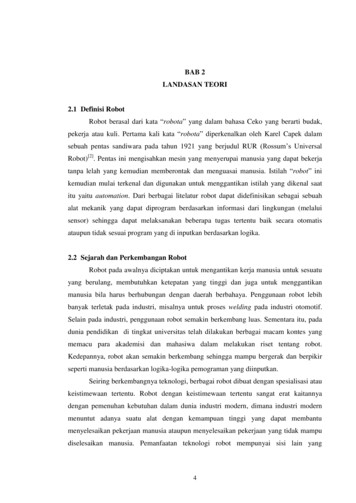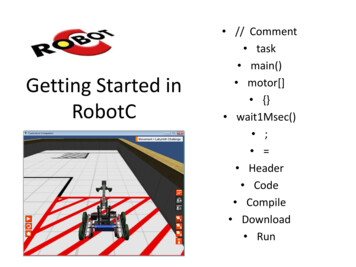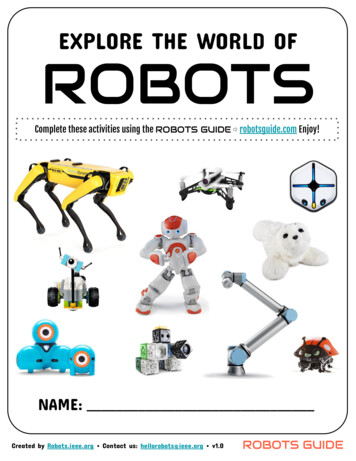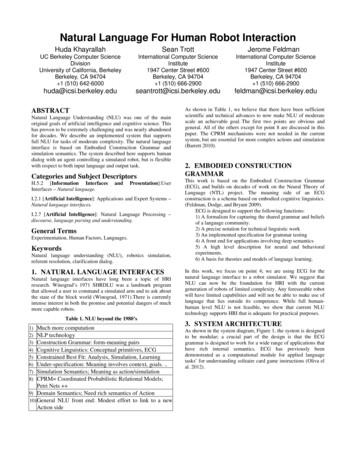
Transcription
Natural Language For Human Robot InteractionHuda KhayrallahSean TrottUC Berkeley Computer ScienceDivisionUniversity of California, BerkeleyBerkeley, CA 94704 1 (510) 642-6000International Computer ScienceInstitute1947 Center Street #600Berkeley, CA 94704 1 (510) 666-2900International Computer ScienceInstitute1947 Center Street #600Berkeley, CA 94704 1 (510) ley.edufeldman@icsi.berkeley.eduABSTRACTNatural Language Understanding (NLU) was one of the mainoriginal goals of artificial intelligence and cognitive science. Thishas proven to be extremely challenging and was nearly abandonedfor decades. We describe an implemented system that supportsfull NLU for tasks of moderate complexity. The natural languageinterface is based on Embodied Construction Grammar andsimulation semantics. The system described here supports humandialog with an agent controlling a simulated robot, but is flexiblewith respect to both input language and output task.Categories and Subject DescriptorsH.5.2 [Information InterfacesInterfaces – Natural language.andPresentation]:UserI.2.1 [Artificial Intelligence]: Applications and Expert Systems –Natural language interfaces.I.2.7 [Artificial Intelligence]: Natural Language Processing –discourse, language parsing and understanding.General TermsExperimentation, Human Factors, Languages.KeywordsNatural language understanding (NLU), robotics simulation,referent resolution, clarification dialog.1. NATURAL LANGUAGE INTERFACESNatural language interfaces have long been a topic of HRIresearch. Winograd’s 1971 SHRDLU was a landmark programthat allowed a user to command a simulated arm and to ask aboutthe state of the block world (Winograd, 1971).There is currentlyintense interest in both the promise and potential dangers of muchmore capable robots.Table 1. NLU beyond the 1980’sMuch more computationNLP technologyConstruction Grammar: form-meaning pairsCognitive Linguistics: Conceptual primitives, ECGConstrained Best Fit: Analysis, Simulation, LearningUnder-specification: Meaning involves context, goals. .Simulation Semantics; Meaning as action/simulationCPRM Coordinated Probabilistic Relational Models;Petri Nets 9) Domain Semantics; Need rich semantics of Action10) General NLU front end: Modest effort to link to a newAction side1)2)3)4)5)6)7)8)Jerome FeldmanAs shown in Table 1, we believe that there have been sufficientscientific and technical advances to now make NLU of moderatescale an achievable goal. The first two points are obvious andgeneral. All of the others except for point 8 are discussed in thispaper. The CPRM mechanisms were not needed in the currentsystem, but are essential for more complex actions and simulation(Barrett 2010).2. EMBODIED CONSTRUCTIONGRAMMARThis work is based on the Embodied Construction Grammar(ECG), and builds on decades of work on the Neural Theory ofLanguage (NTL) project. The meaning side of an ECGconstruction is a schema based on embodied cognitive linguistics.(Feldman, Dodge, and Bryant 2009).ECG is designed to support the following functions:1) A formalism for capturing the shared grammar and beliefsof a language community.2) A precise notation for technical linguistic work3) An implemented specification for grammar testing4) A front end for applications involving deep semantics5) A high level description for neural and behavioralexperiments.6) A basis for theories and models of language learning.In this work, we focus on point 4; we are using ECG for thenatural language interface to a robot simulator. We suggest thatNLU can now be the foundation for HRI with the currentgeneration of robots of limited complexity. Any foreseeable robotwill have limited capabilities and will not be able to make use oflanguage that lies outside its competence. While full humanhuman level NLU is not feasible, we show that current NLUtechnology supports HRI that is adequate for practical purposes.3. SYSTEM ARCHITECTUREAs shown in the system diagram, Figure 1, the system is designedto be modular; a crucial part of the design is that the ECGgrammar is designed to work for a wide range of applications thathave rich internal semantics. ECG has previously beendemonstrated as a computational module for applied languagetasks’ for understanding solitaire card game instructions (Oliva elal. 2012).
Figure 1: The system diagram.3.1 Supported InputTable 2 highlights a representative sample of working input,corresponding to the scene in Figure 2. There is an obvious focuson motion, due to the functionality of the robot used. The locationto which the robot is instructed to move can include specificlocations “location 1 2,” and specific items “Box1.” The systemcan also handle more complicated descriptions, using color andsize. Additionally, when the user references an indefinite object,such as, “a red box,” and there are multiple objects that fit thedescription, one of the objects that satisfies the condition ischosen randomly. For definite descriptions, such as “the red box”,the system requests clarification, asking: “which red box?”Table 2:Sample supported input (English)The main modules are the analyzer, the specializer, the problemsolver, and the robot simulator. The analyzer semantically parsesthe user input with an ECG grammar plus ontology and outputs adata structure called the SemSpec.The specializer crawls the SemSpec to capture the task relevantinformation, which it sends to the problem solver as a datastructure called an n-tuple. The problem solver then uses theinformation from the n-tuple, along with the problem solver’sinternal model of the world, to make decisions about the worldand carry out actions. Additionally, the problem solver updates itsmodel of the world after each action, so it can continue to makeinformed decisions and actions.While this paper focuses on English, the system also works inSpanish. The same analyzer, N-tuples, problem solver, andsimulator can be used without alteration. Spanish and Englishhave major grammatical differences; therefore, they use differentconstructions, so a modified specializer is needed. The specializerextracts the relevant information and creates the same n-tuple.This allows the problem solver and robot simulator to remainunchanged.In addition to the application to robotics, a similar architecture isalso used for metaphor analysis. For this domain, moreconstructions must be added to the grammar, but the sameanalyzer can be used. Instead of carrying out commands in asimulated world, metaphors and other information from theSemSpec are stored in a data structure, which can be queried forfrequency statistics, metaphor entailments, and inferences about aspeaker’s political beliefs.BlueRedGreenRedFigure 2: The Simulated World.1)2)3)4)5)6)Robot1, move to location 1 2!Robot1, move to the north side of the blue box!Robot1, push the blue box East!Robot1, move to the green box then push the blue box South!Robot1, if the small box is red, push it North!where is the green box?7) is the small red box near the blue box?8) Robot1, move behind the big red box!9) which boxes are near the green box?Table 3:Sample supported input (Spanish)1)2)3)4)Robot1, muévete a posición 1 2!Robot1, muévete al parte norte de la caja azul!Robot1, empuje la caja azul al este!Robot1, muévete a la caja verde y empuje la caja azul al sur!5)6)7)8)Robot1, si la caja pequeña es roja, la empuje al norte!dónde está la caja verde?está la caja roja y pequeña cerca de la caja azul?Robot1, muévete detrás de la caja roja y grande!9) cuáles cajas están cerca de la caja verde?In addition to commands involving moving and pushing, thesystem can also handle yes or no questions—as demonstrated inExample 7 in Table 2. Example 5 demonstrates a conditionalimperative; the robot will only perform the instruction if thecondition is satisfied. The system can also handle basic referentresolution, as demonstrated in Example 5. This is done bychoosing the most recent antecedent that is both syntactically andsemantically compatible. This method is described in (Oliva et al,2012) and is based on the way humans select antecedents.The total range of supported input is considerably greater than thesentences included in the tables; this sample is intended to give asense of the general type or structure of supported input in bothEnglish and Spanish.If the analyzer cannot analyze the input, the user is notified andprompted to try typing the input again. If the user attempts todescribe an object that does not exist in the simulation, the systeminforms the user, “There is no object that matches that description.Please try again.”If there is more than one object that matches an object’sdescription (e.g. “red box”), and a definite article is used (e.g. “the
red box”), the system asks for clarification, such as: “which redbox?” The user can then offer a more specific description, such as:“the small one.”4. Extended Example: Robot SimulationIn order to demonstrate the integration and functionality of thesystem, we will trace an extended example from text to action.We will consider the command, “Robot1, if the box near the greenbox is red, push it South!” This is discussed in the context of theexample situation in Figure 2, the system diagram of Figure 1, andthe supplementary video.4.1 AnalyzerThe input text is first parsed by the analyzer program using theECG grammar. The analyzer uses syntactic and semanticproperties to develop a best-fit model and produce a SemSpec.This SemSpec is a grammatical analysis of the sentence,consisting of conceptual schemas and their bindings (Bryant2008). A constructional outline of the SemSpec for this examplecan be found in Appendix A.4.2 SpecializerThe specializer extracts the relevant information for the problemsolver from the SemSpec. This output is in the form of an n-tuple,a data structure implemented using Python dictionaries.The ntuple for this example can be found in Appendix B. Our Pythonbased n-tuple templates are a form of Agent CommunicationLanguage; although the content of the n-tuples changes acrossdifferent tasks and domains (such as robotics and metaphoranalysis), the structure and form can remain the same. When newapplications are added, new n-tuple templates are defined tofacilitate communication with the problem solver. The n-tuplesare not limited to a Python implementation.In this case, the command is in the form of a conditional, so thespecializer must fill in the corresponding template by extractingthe bindings from the SemSpec.Additionally, the direct object of the “push” command is apronoun; the analyzer cannot match pronouns with theirantecedents, so the specializer uses a combination of syntactic andsemantic information to perform reference resolution (Oliva et al,2012). In this case, the antecedent of “it” is “the box near thegreen box”, so the specializer passes this information to theproblem solver in the n-tuple.4.3 Problem SolverThe problem solver parses the n-tuple to determine the actionsneeded, and then performs those actions. It begins by determiningthe type of command, which is here a conditional. Before itperforms the command, it must evaluate the truth of the condition.In this example, the problem solver must determine which box is“near the green box” and then determine whether that box has theproperty red. Using the information provided by the specializer,the solver searches through its data structure, which contains thecurrent and updated state of the simulated world. Once the solveridentifies the box that is located near the green box, it canevaluate whether that box is red using its vision system or worldknowledge.If the condition is satisfied, the robot performs the specifiedaction: in this case, “push it [the box near the green box] South!”This action is considerably more complex than simply moving toa box, and involves a nontrivial amount of trajectory planning.First, the solver disambiguates the location of the box bysearching through its data structures. Then, it determines that topush the box South, it must move to the North side of the box(avoiding obstacles along the way), rotate to face the box, andmove South. This results in pushing the box South.Finally, the call to execute a move action is made through thewrapper class of the robot or simulator API, here MORSE. Thisadditional level of abstraction allows the system to work with anarbitrary robot or simulator, assuming it supports the sameprimitives.4.4 SimulatorThe demo system is built on top of MORSE (Echeverria et all),which in turn relies on Blender for 3d visualization. MORSE is anopen-source simulator designed for academic robotics. While oursystem is designed to work on an arbitrary simulator, it has beeninfluenced by the specifications of this one. MORSE providessome useful functionality, including realistic physics anda varietyof interfaces (including the Python bindings we use). It also hassome key limitations, such as restricted functionality and the lackof path planning. The use of Blender allows for realistic physicssimulations, and easy modeling.4.5 Alternate PlatformsWhile we demo our system with the MORSE simulator, we arealso considering physical robot platforms. A leading option is theQRIO robot, which was developed by Sony. We are working onincorporating QRIO in conjunction with a research partner and areexploring other possibilities.4.6 Additional System FeaturesThe system also incorporates several other key features that aidboth its semantic understanding and its functionality. First, asmentioned above, the specializer performs basic referentresolution between pronouns and their antecedents. This is doneby maintaining a LIFO stack of the syntactic heads of pastNominal Phrases; when a pronoun is encountered, the specializermatches its syntactic and semantic context with the most recentcompatible object reference on the stack. This procedure issomewhat novel because it incorporates semantic features, as wellas syntactic ones, in determining the compatibility of a pronounand its antecedent. For example, if the robot is instructed to“push” something, the specializer checks that the antecedent is“movable”, using the ontology lattice.Second, the specializer resolves cases of the “anaphoric one”using a related but distinct method. The usage of the anaphoricone is problematic because it often refers simply to anantecedent’s category. For example, in the sentence “John has ared cup and I have a green one”, one refers to the category of“cup”. Research suggests that discourse and semantic context arenecessary for proper resolution (Salmon-Alt et al, 2001). Oursystem has semantic and world knowledge, and it uses thesecontextual features in the resolution process; qualifiers in theantecedent, such as “red”, are compared with the anaphor’squalifiers (“green”), and are added iteratively until the system isable to locate a referent in the simulated world.Finally, the system handles under-specified input via appropriateclarification dialogs. The problem solver has information aboutthe simulated world, so it can determine when to query the userfor more information. If the user instructs the robot to move to“the red box”, and there are two red boxes, the system asks:
“which red box?” The user might reply: “the small one”. Thisclarification process allows the system to interact with the user,and continues until the input is properly specified. It then usesone-anaphora resolution to determine the correct referent.5. RELATION TO PRIOR WORKIn addition to the early work on SHRDLU, there has also beensome recent work on using natural language to control robots. Incontrast to Winograd’s work— as well as our own— theseapproaches focus on learning from examples (Howard et al.2014).Both our work and Winograd’s focus on a specific domain(Winograd, 1971). SHRDLU knew the properties of blocks, andunderstood how to interact with them specifically. While ourAnalyzer is general, our Problem Solver (Figure 1) is specific toeach application.SHRDLU analyzed the sentence in terms of the definitions of theindividual words. It was not designed to be adapted to differenttasks. In contrast, our modular system allows for portions to beused for different tasks (such as metaphor analysis). ForSHRDLU, language understanding was highly coupled with thesimulated world, and the world was resimulated based on thelanguage. In order to model a more realistic interaction withrobots, our problem solver issues commands to a robot simulatorAPI, which could be replaced with a robot API.Recent work has also approached the problem of providing anatural language interface for robots. Matuszek et al. learned aparser based on pairs of English commands and control languageexpressions In contrast, our work builds upon the EmbodiedConstruction Grammar, which we believe allows us to betterunderstand the intentions of the human.Other work has focused on robots asking humans for help whenstuck (Tellex et al.). We implement a basic request forclarification, since scope of our work is to perform commandsissued by the user. However, in an environment where the robothas more autonomy, the need to ask with assistance on a task—and not just ask for clarification about a command—can becrucial. All of this requires a much richer NLU system, like ECG.6. CONCLUSIONThis paper demonstrates a fully integrated yet modular systemthat provides a natural language interface, based on embodiedsemantics, to a robotic simulator. In combination with (Oliva et al,2012) this demonstrates that the ECG and Analyzer architectureof Figure 2 can be used for diverse applications: solitaire, roboticcontrol, and metaphor analysis. The Spanish version furtherillustrates the flexibility of the system. The use of the ECG allowsfor a deep semantic understanding, which supports full treatmentof different input languages, as well as providing solid frameworkfor analyzing embodied concepts, such as motion and spatialrelations. The main goal of this work is not just in the domain ofrobotics, but rather a general NLU front end for autonomoussystems.6.1 LimitationsThe primary limitation of the current system is scale. We haveimplemented and tested English grammars much richer thanshown here, but well short of complete coverage (Feldman,Dodge, and Bryant 2009). This is a focus of current research. Inorder to facilitate more natural interactions, we have also begunthe integration of a spoken language recognizer6.2 Ongoing WorkThis project is still in active development. In the domain ofrobotics, we have begun to study more complex (possiblyhumanoid) robots operating in complex real-world situations. Weare also exploring totally different NLU tasks including theinterpretation of metaphorical language.On the system level, scaling remains the core issue. Theconstructional structure of a language (e.g., English) is complexbut bounded. We believe that enough is now understood tosupport realization of the fixed compositional subset of alanguage.We have also implemented a morphological pre-processingsystem that reduces the number of necessary constructions andexploits the existing schema lattices in the grammar. Additionally,we have reduced the need for lexical constructions by developinga new method of expanding the lexicon, which involves inserting“tokens” of various syntactic and semantic categories into a tokenlist (e.g., “red” is a token of the “color” type). The tokens do notneed to be read in when the grammar is compiled. This allows usto significantly increase the size of the lexicon, while maintainingthe complex semantics of the grammar.For full coverage, the lexicon and idiomatic usage of each domainwill need to be captured, almost certainly through incrementalmachine learning. Syntactic and semantic usage frequencies canbe exploited as well.For coupling the general NLU front end to varying applicationdomains, some additional system work should be done. As withany system coupling, the ontology referenced by Analyzer needsto be shared with that of the Problem Solver in order to give bothmodules the relevant information about the terms used. We arehopeful that RDF/OWL will be helpful here, but have not triedthis yet.7. ACKNOWLEDGMENTSWe thank Luca Gilardi of the International Computer ScienceInstitute for his help in designing the system framework, as wellas creating the GUI for the ECG Workbench Editor.8. REFERENCES[1] Barrett, L. R. 2010. An Architecture for Structured,Concurrent, Real-Time Action. Ph.D. diss., Department ofComputer Science, University of California at Berkeley[2] Bryant, J. E. 2008. Best-Fit Constructional Analysis. Ph.D.diss., Department of Computer Science, University ofCalifornia at Berkeley[3] Chang N. 2008. Constructing grammar: A computationalmodel of the emergence of early constructions. Ph.D. diss.,Computer Science Division, University of California atBerkeley[4] Echeverria, G.; Lassabe, N.; Degroote, A. and Lemaignan, S.2011. Modular open robots simulation engine: Morse. In theproceedings of the 2011 IEEE International ConferenceRobotics and Automation, 46-51 IEEE.
[5] Feldman J.; Dodge E.; and Bryant J. A Neural Theory ofLanguage and Embodied Construction Grammar. In TheOxford Handbook of Linguistic Analysis, Heine B. andNarrog H. 111-138, Oxford University Press, 2009[6] Howard, T. M., Tellex, S., and Roy, N. 2014. A NaturalLanguage Planner Interface for Mobile Manipulators. InProc. IEEE Int’l Conf. on Robotics and Automation (ICRA).[7] Matuszek, M; Herbst, E, Zettlemoyer, L; and Fox, D. 2012.Learning to Parse Natural Language Commands to a RobotControl System. In Proceedings of the InternationalSymposium on Experimental Robotics (ISER)[8] Mok E., 2008. Ph.D. diss., Department of Computer Science,University of California, Berkeley, CA[9] Oliva J.; Feldman J.; Giraldi L. and Dodge E. OntologyDriven Contextual Reference Resolution in EmbodiedConstruction Grammar. 2012. In the proceedings of the 7thAnnual Constraint Solving and Language ProcessingWorkshop. Orléans, France[10] Salmon-Alt, S; Romary, L. Reference Resolution Within theFramework of Cognitive Grammar, 2001. InternationalColloquium on Cognitive Science, San Sebastian: Spain.[11] Tellex, S; Knepper, K; Li, A; Rus, D; and Roy, D. 2014Asking for Help Using Inverse Semantics. Proceedings ofRobotics: Science and Systems, Berkeley, CA[12] Winograd, T. 1971 Procedures as a Representation for Datain a Computer Program for Understanding Natural Language,Technical Report 235, MIT AI
Appendix A: SemSpec example(Below is the Analyzer’s SemSpec output for the sentence: “Robot1, if the box near the green box is red, push it South!” Inorder to conserve space and also illustrate the entire constructional tree, many of the constructional roles and schemas havebeen collapsed.)
Appendix B: n-tuple example“Robot1, if the box near the green box is red, push it South!”(Below is a representation of the N-Tuple; the actual Python code is shown in the supplementary materials.)Return type: error descriptor,Predicate type: conditionalParameters:Kind: ConditionalCondition:Protagonist: Object-Descriptor:Type: boxGivenness: uniquely-IdentifiableLocation-Descriptor:Relation: NearObject-Descriptor:Type: boxGivenness: Uniquely-IdentifiableColor: greenPredication: (Color: Red)Kind: QueryAction: beCommand:Kind: causeCausal-Process:Protagonist: Robot1 instanceControl State: OngoingSpeed: 0.5Distance: (units: square, value: 8)Acted-Upon: Object-Descriptor:Type: BoxGivenness: Uniquely-IdentifiableLocation-Descriptor:Relation: NearObject-Descriptor:Type: boxGivenness: Uniquely-IdentifiableColor: greenKind: ExecuteAction: Force-ApplicationAffected-Process:Direction: NoneProtagonist: Object-DescriptorType: BoxGivenness: Uniquely-IdentifiableLocation-Descriptor:Relation: NearObject-Descriptor:Type: boxGivenness: Uniquely-IdentifiableColor: greenHeading: SouthControl state: OngoingSpeed: 0.5Distance: (units: square, value: 8)Kind: ExecuteCauser: Robot1 instanceAction: push move
problem solver in the n-tuple. 4.3 Problem Solver The problem solver parses the n-tuple to determine the actions needed, and then performs those actions. It begins by determining the type of command, which is here a conditional. Before it performs the command, it must evaluate the truth of the condition. In this example, the problem solver must .

